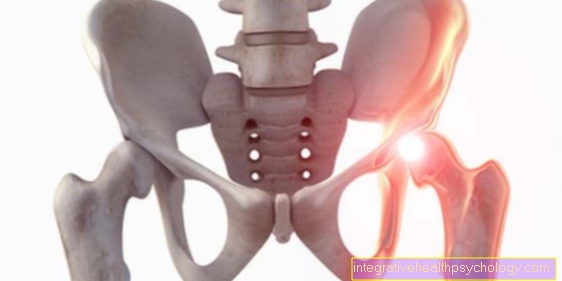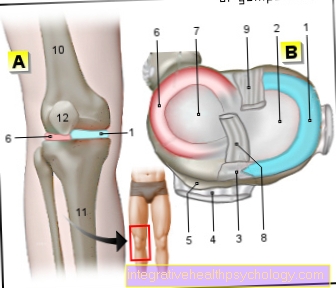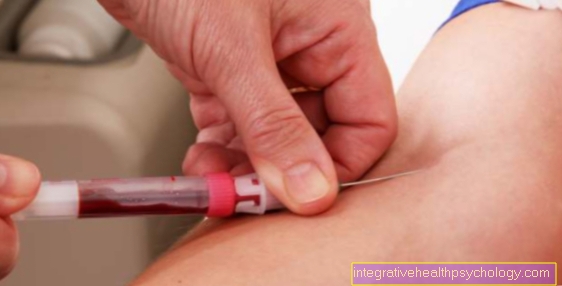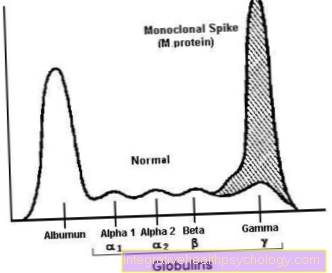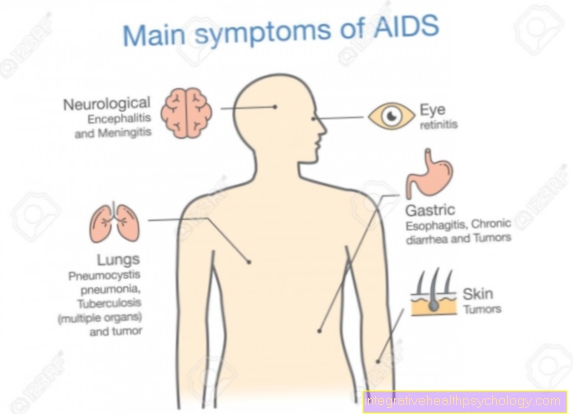Thymus
synonym
Bries
definition
The thymus is an unpaired lymphoid organ (part of the lymphatic system) that is located in the chest in the front part of the middle layer. So it lies over the heart as well as behind the breastbone. Laterally, the thymus is covered by the pleura on both sides. In most cases it develops from the third pharynx. Since it serves the primary development of T cells, it becomes like bone marrow (Equivalent for B cells) called the primary lymphatic organ.
Read detailed information on: Lymphatic organs
Structure of the thymus

The organ is made up of two asymmetrical lobes connected to one another. Connective tissue divides the lobes into further small lobes. The size of the thymus depends on age. In childhood it reaches its maximum size with an average weight of 30g. Involution begins especially after puberty (reduction) of the organ, in which the thymus tissue is gradually replaced by functionless fatty tissue. In adulthood, there is only a residual thymus body with an average weight of 18g. This is often referred to as the retrosternal fat body.
When viewed microscopically, the thymus base tissue can be divided into a cell-rich cortex and a medulla located further inside. Especially in the latter are the Hassall bodies typical of the thymus, which probably represent onion-like aggregations of epithelial cells (cells of surfaces). Their function has not yet been clarified. In the cortex, on the other hand, the thymocytes lie in a framework made up of epithelial cells. Therefore, the thymus is the only one of all lymphatic organs called the lymphoepithelial organ.
Function and role of the thymus
The thymus is responsible for the development and differentiation of immune cells, the so-called T cells. The thymus is a kind of training center for these cells: Immature cells that are formed in the bone marrow migrate into the thymus via blood vessels. There they are called thymocytes. After several divisions, the thymocytes migrate from the cortex through the thymus lobe in the direction of the medulla. In this way they mature and receive the T cell receptor, a protein that is anchored in the surface of T cells and is able to recognize antigens. When it comes to maturation, a distinction is made between a positive and a negative selection, depending on whether the antigens are endogenous or foreign. At the beginning there is a positive selection. Only those cells are allowed to develop further whose receptor recognizes peptides via so-called MHC molecules, but does not bind them too strongly. This is followed by the negative selection. To ensure that the T cell does not attack the body's own structures, the cells that tolerate them are selected (Self tolerance). All cells that do not meet these criteria die from programmed cell death (Apoptosis). A mere 5-10% of all T cells survive maturation. Only these cells get into the blood in order to then colonize the secondary lymphatic organs. In addition to its function as an immune organ, the thymus also functions as a hormonal gland. The messenger substances produced, thymosin, thymopoietin and thymus factor, influence the maturation of immune cells in the lymphatic organs.
Read more on the subject under: T lymphocytes
location
The thymus is located relatively anatomically centrally behind the upper part of the sternum. The position of the thymus is then quasi on the large venous and arterial Blood vesselsthat arise there directly at the point of the heart or flow into it. A further limitation of the position of the thymus takes place through Connective tissue plates instead, which divide the rib cage inside into different areas.
Because the thymus significantly larger at a young age is then in adulthood, the extent can vary accordingly. Nevertheless, the situation remains between the sternum and the large blood vessels, as well as partly the pericardium, are usually preserved for life. In order to determine the position of the thymus in yourself, you can feel your fingers starting from the collarbones to the sternum and then about a hand's breadth down the sternum.
Thymectomy
Surgical removal of the thymus (Thymectomy) would have the consequence in the child that the immune system cannot be adequately trained. However, this method is used for the clinical picture of the Myasthenia gravis advantage. This is based on an autoimmune reaction against receptors on the neuromuscular endplate of the muscles, which leads to progressive muscle weakness. About half of the patients with myasthenia gravis have an enlargement of the thymus, which can be associated with a thymoma (usually benign tumor of the thymus). Since the tumor cells have antigens that are similar to the muscle receptor, the autoimmune response is intensified. Therefore, surgical removal of the thymus usually significantly alleviates the patient's symptoms.
Knocking off the thymus
If you have the feeling that you are increasingly weak, tired or exhausted, you can get through according to a new method Tapping on the thymus this activate and for more energy and ensure a strengthened immune system. This can be done, for example, by a increased blood flow be explained.
Tapping on the thymus can be done at will once or several times a day to repeat. One looks for the in an upright posture middle of Sternum in the center line and tap lightly with your fist or fingertips either on this one spot or in circular motions around it.
How often or for how long you tap on the thymus in an exercise can be varied individually depending on the effect. It will, however half a minute to a full minute recommended. You can also try yourself relaxby closing your eyes, for example, or breathing deeply in and out.


